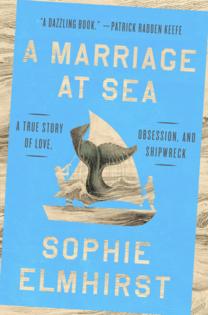Review: A shipwreck is just the start of a couple's race to survive in 'A Marriage at Sea'
Published in Books News
Sure, you can survive a shipwreck, but have you ever tried surviving a marriage?
That’s what Sophie Elmhirst contemplates in her riveting, feisty “A Marriage at Sea.” It’s a narrative nonfiction look at Maurice and Maralyn Bailey, an English couple who embarked on an oceanic life in 1972, were rammed into by a whale on their way to the Galapagos Islands and then had to endure months in an inflatable life raft, with few provisions and no company but each other and the occasional turtle.
The story is a jaw-dropper, which Elmhirst relates with the help of excerpts from their accounts, lists of the few items they salvaged from their sunken sailboat (radio not included — they chose to sail without one) and interviews with others who knew the couple. But, as harrowing and gripping as the Baileys’ story is, the real star of this book is its dazzling writer.
Elmhirst succeeds at everything she attempts. Her take on the couple’s plight is often poetic, like this description of the Pacific:
“It can seem like a desert, this ocean, featureless and empty. But deep down, there is landscape, peaks and valleys, whole mountain ranges. There are whales sleeping vertically with their calves, or clicking messages to each other as they search for squid. Baby turtles swim out into the open ocean, their flippers pumping back and forth.”
But it’s not just a book of lovely musings about nature. Elmhirst also has a skilled journalist’s abilities to spot telling details (get this: Maralyn couldn’t swim) and to get right to the point, as in this moment shortly after the wreck:
“Maurice, who knew more about the winds and currents, didn’t tell her how unlikely it was that they’d be blown in the right direction. He found himself wondering if they had enough gas in the canister to kill themselves.”
Sometimes, it’s almost like Elmhirst is the couple’s therapist:
“Usually, the stars lend perspective, a leavening sense of one’s own insignificance. Maurice looked up and saw only himself, only his flaws; the hope that he might become someone better.”
As that bit of analysis hints, Maralyn dealt better with the shipwreck than her husband did, and “even in their arguments, she could find light, sensing that they were developing a deeper respect for each other’s opinions.”
As Elmhirst describes it, Maralyn’s resourceful optimism and Maurice’s gloom and doom were a pairing that worked at sea, maybe even better than it had on land. And this is the real meat of the book: curiosity about how an experience so horrifying that it would have, at best, severely strained most marriages somehow strengthened the Baileys’. Like “Who’s Afraid of Virginia Woolf,” except without all the yelling and drinking, “A Marriage at Sea” is a clear-eyed, insightful anatomy of a marriage.
Just about every moment in “A Marriage at Sea” is full of drama and tension but even the few respites when lives are not at stake — a pre-voyage dinner with friends, for instance, or Maurice’s solitary trip to a bar — are compelling, so deep is Elmhirst’s understanding of these two people.
Which is why she deserves the mic drop here: “Somewhere, deep within, unspoken, we must know, we do know, that we’ll all have our time adrift. For what else is a marriage, really, if not being stuck on a small raft with someone and trying to survive?"
____
A Marriage at Sea
By: Sophie Elmhirst.
Publisher: Riverhead, 246 pages.
©2025 The Minnesota Star Tribune. Visit at startribune.com. Distributed by Tribune Content Agency, LLC.













Comments